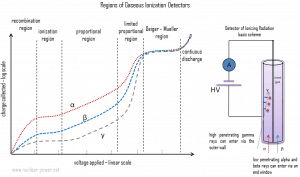A proportional counter, also known as the proportional detector, is an electrical device that detects various types of ionizing radiation. The voltage of the detector is adjusted so that the conditions correspond to the proportional region. In this region, the voltage is high enough to provide the primary electrons with sufficient acceleration and energy to ionize additional atoms of the medium. These secondary ions (gas amplification) formed are also accelerated, causing an effect known as Townsend avalanches, which creates a single large electrical pulse. Gaseous proportional counters usually operate in high electric fields of 10 kV/cm and achieve typical amplification factors of about 105. Since the amplification factor strongly depends on the applied voltage, the charge collected (output signal) also depends on the applied voltage, and proportional counters require constant voltage.
Multi-wire Proportional Chamber – MWPC
A multi-wire proportional chamber is a type of proportional counter used especially in high-energy particle physics to detect charged particles and photons and give positional information on their trajectory. This device was developed by Georges Charpak and his collaborators, and this invention resulted in him winning the Nobel Prize for Physics in 1992. The multi-wire chamber uses an array of wires at high voltage (anode), which run through a chamber with conductive walls held at ground potential (cathode). The principle is to have a plane of anode wires positioned precisely, with typical wire-spacings of about 2 mm. Computing pulses can find the particle trajectory from all the wires.
